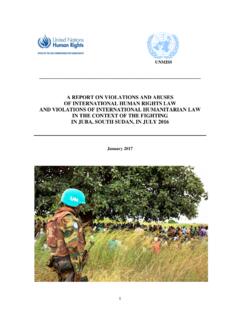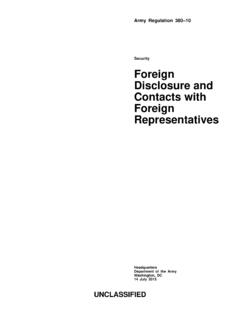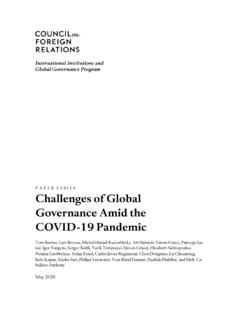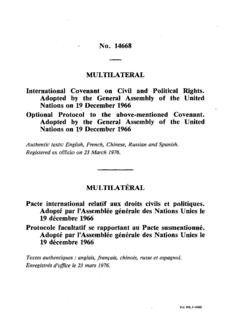Transcription of UN Peacebuilding: an Orientation
1 UN Peacebuilding: an OrientationWe the peoples of the United nations determined to save succeeding generations from the scourge of war, Which tWice in oUr lifetime has broUght Untold sorroW to mankind, and to reaffirm faith in fundamental human rights, in the dignity and Worth of the hUman person, in the equal rights of men and Women and of nations large and small, and to establish conditions Under Which jUstice and respect for the obligations arising from treaties and other soUrces of international laW can be maintained.
2 And to promote social progress and better standards of life in larger freedom, and for these ends to practice tolerance and live together in peace With one another as good neighboUrs, and to Unite oUr strength to maintain international peace and security, and to ensUre, by the acceptance of principles and the institUtion of methods, that armed force shall not be Used, save in the common interest, and to employ international machinery for the promotion of the economic and social advancement of all peoples, have resolved to combine oUr efforts to accomplish these the peoples of the United nations determined to save sUcceeding generations from the scoUrge of War, Which tWice in oUr lifetime has broUght Untold sorroW to man-kind, and to reaffirm faith in fUndamental hUman rights, in the dignity and Worth of the hUman person, in the eqUal rights of men and Women and of nations large and small.
3 And to establish conditions Under Which jUstice and re-spect for the obligations arising from treaties and other soUrces of international laW can be maintained, and to pro-mote social progress and better standards of life in larger freedom, and for these ends to practice tolerance and live together in peace With one another as good neighboUrs, and to Unite oUr strength to maintain international peace and secUrity, and to ensUre, by the acceptance of principles and the institUtion of methods, that armed force shall not be Used, save in the common interest, and to employ in- ternational machinery for the promotion of the eco-nomic and social advancement of all peoples, have re-solved to combine oUr efforts to accomplish these Peacebuilding: an OrientationUnited NationsPeacebuilding Support OfficeSeptember 2010 TABLE OF CONTENTSFOrEwOrd SECTiON i.
4 ThE SCOPE OF PEACEBUiLdiNg Definitions and concepts 5 The political context of peacebuilding 5 Essential features of peacebuilding 5 Phases of peacebuilding 6 Peacebuilding s relation to conflict prevention, peacekeeping, peacemaking, humanitarian and development assistance 8 The most frequent needs 12 Setting peacebuilding priorities 12 The need for conflict sensitivity 14 Challenges of peacebuilding 16 SECTiON ii: PLANNiNg FOr PEACEBUiLdiNg international community planning processes 27 Constraints to effective planning 29 international and regional actors involved in peacebuilding 29 women s participation in peacebuilding 30 SECTiON iii: rESOUrCES FOr PEACEBUiLdiNg The UN s peacebuilding architecture 37 The UN Peacebuilding Fund 37 Other sources of funding for peacebuilding 39 Support from the Peacebuilding Support Office (PBSO) 43 ANNEx i: ThE EvOLUTiON OF PEACEBUiLdiNg.
5 KEy UN dEFiNiTiONS ANd rELATEd CONCEPTS 44 ANNEx ii: LiST OF ACrONymS 501By Judy Cheng-Hopkins, Assistant Secretary-General for Peacebuilding SupportBuilding peace in countries emerging from conflict is a huge, complex undertaking. It involves a myriad of different players. Its very definition is the subject of vigorous debate. Those of us who work as peacebuilders are therefore faced every day with the question: how do we build sustainable peace?This paper aims to bring some clarity to the perspective of the peacebuilder, especially the UN peacebuilder.
6 It is not an academic study of peacebuilding, nor does it offer definitive solutions to its problems. Instead, it contains practical guidance on how to deal with the recurring challenges of planning, programming, prioritization and resources. To enhance its practical relevance, the paper contains many examples of real life peacebuilding, its mistakes as well as its successes. These are lessons shared by our UN colleagues who carry out peacebuilding in the field.
7 They illustrate how the principles described in this paper apply in actual peacebuilding situations. This paper is aimed at UN and other practitioners who may have wide experience in other areas but who are relatively new to peacebuilding, particularly partners of the UN Peacebuilding Support Office (PBSO), such as those working with the Peacebuilding Commission or implementing Peacebuilding Fund projects. Much of the paper is based on the Report of the Secretary-General on Peacebuilding in the Immediate Aftermath of Conflict of June 2009, which addressed peacebuilding throughout the UN system.
8 The focus of that report was the first two years after the main conflict ends: a crucial window of opportunity to get early peacebuilding activities underway, yet one which the international community has too often missed. But peacebuilding is not restricted to that early period. This paper recognizes, therefore, that peacebuilding is typically a much longer-term process. The Peacebuilding Fund, for example, can support peacebuilding for several years after conflict has involves a great number and variety of stakeholders starting with the citizens of the countries themselves where peacebuilding is underway.
9 It is neither a purely political, security nor developmental process, but one that must bring together security, political, economic, social and human rights elements in a coherent and integrated way. This paper, therefore, is a collective endeavour, developed by PBSO in conjunction with many other parts of the UN system engaged in peacebuilding, whose contribution I gratefully acknowledge. FOREWORD 3 Launch of the Sport for Peace Programme aimed at promoting reconciliation and development in Liberia.
10 This cultural performance was part of the Sport for Peace soccer tournament launch. UN Photo/Eric Kanalstein5dEFiNiTiONS ANd CONCEPTST here are many possible definitions of peacebuilding and varying opinions about what it involves. The term itself first emerged over 30 years ago through the work of Johan Galtung, who called for the creation of peacebuilding structures to promote sustainable peace by addressing the root causes of violent conflict and supporting indigenous capacities for peace management and conflict became a familiar concept within the UN following Boutros Boutros-Ghali s 1992 report, An Agenda for Peace.













